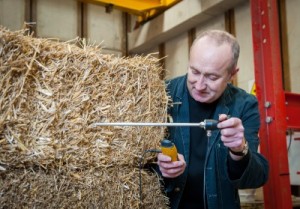Research from the University of Bath’s Department of Architecture & Civil Engineering has resulted in the UK’s first affordable straw homes going on sale this week.
The houses are an affordable, low carbon and fuel-efficient means of housebuilding with fuel bills up 90% cheaper than an equivalent brick-built house. Part-desinged by Bath-based Integral Engineering Design, they also cost less to buy than the average house in Bristol, where the first examples went on sale.
Straw houses had not been a realistic option for homebuilders due to a lack of certified materials and concerns about durability. 
However, a new factory-built straw panel design developed at the university has received BM Trada’s Q mark certification, meaning developers and house buyers can now insure and secure mortgages against homes, schools and offices built using this sustainable construction method.
The seven innovative Bristol townhouses were built by developers Connolly and Callaghan using the innovative 3.2m by 2.9m ModCell straw panels, in which an engineered timber frame encloses the compressed straw bale insulation.
Constructed with the load-bearing straw panels within an airtight design (plus triple glazed windows) the new houses will need significantly less conventional heating. Their super-insulated straw walls provide three times’ greater insulation than required by current UK building regulations – meaning fuel bills are anticipated to fall by up to 90%.
The Q mark industry certification is the result of the university’s three-year, 1.8m euro EuroCell research project funded by the Executive Agency for Small and Medium-sized Enterprises (EASME) jointly with industry partners Integral Engineering Design and Bristol architects White Design.
To receive certification the university’s researchers tested the ModCell straw panel’s energy efficiency, fire safety, durability and weather-resilience; including exposing the panels to heavy rain and extreme temperatures ranging from -20oC to 50oC.
Head of the Department of Architecture & Civil Engineering, Professor Pete Walker, led the research, which previously entailed building the innovative prefabricated straw bale building called the BaleHaus as a test site in 2009.
He said: “The construction sector must reduce its energy consumption by 50% and its carbon emissions by 80% by 2050, so radical changes are needed to the way we approach house building. As a construction material straw is a low-cost and widely available food co-product that offers real potential for ultra-low carbon housing throughout the UK. Building with straw could be a critical point in our trajectory towards a low-carbon future.”
In the UK up to 7m tonnes of straw remains after the production of wheat flour, and up to half this amount is effectively discarded due to its low value, to be used as animal bedding. This ‘leftover’ 3.8m tonnes of straw could be used to build over 500,000 homes, as an average three-bedroom house needs 7.2 tonnes of straw.



















